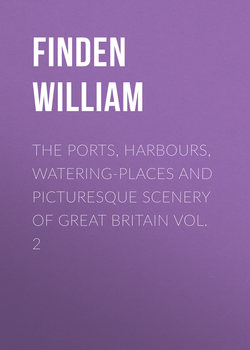Читать книгу The Ports, Harbours, Watering-places and Picturesque Scenery of Great Britain Vol. 2 - Finden William - Страница 1
BERWICK. – LIGHTHOUSE ON THE PIER
ОглавлениеThe view of the Lighthouse, at the head of Berwick Pier (which forms the vignette to our Second Volume), is taken from the entrance to the harbour, about half a mile below the bridge. This Pier, the building of which was commenced in 1810, stands on the north side of the river, and is chiefly erected on the foundations of an old one, which is said to have been built in the reign of Queen Elizabeth. From the lighthouse, which was finished in 1826, two lights are exhibited at night, the one above the other. The upper one, which is of a pale, white colour, is lighted from sunset to sunrise; the lower one, which is of a bright red, is a tide-light, and is only displayed during the time that there is ten feet water on the bar.
Berwick Harbour is not well adapted for vessels of large burthen, for the greater part of the shore, in front of the quay, is dry at low water. On the Tweedmouth side, near the Car Rock, is the best water within the bar; and a vessel drawing from sixteen to eighteen feet water may lie there at all hours of the tide without touching the ground. The entrance to the harbour is narrow, as a bank of sand stretches out to the eastward, from the Spittal shore, to the extent of nearly half a mile, and approaches to within a cable's length of the rocks on the north. When the wind is from the eastward, there is always a swell on the bar; and the ebb-tide – more especially when there is a fresh in the river, in consequence of rain – runs out with such velocity that it is impossible for a vessel to make head against it. Vessels bound for Berwick, which cannot take the harbour in bad weather, usually seek shelter in Leith Roads.
The salmon fishery forms a most important branch of the trade of Berwick. About the middle of the last century, the fish used chiefly to be conveyed to London by small vessels of about forty tons burthen, belonging to Harwich and Gravesend, engaged by the London dealers; the fresh-caught salmon and gilse were conveyed in wells in the hold, but a large portion was sent pickled in kits. About 1787, the practice of packing salmon in pounded ice was suggested by George Dempster, Esq., of Dunnichen, then M.P. for Cupar, to Mr. John Richardson, a salmon-dealer, of Perth, who immediately adopted it; and the next year the salmon-dealers of Berwick followed his example.
Most of the salmon sent from Berwick to London are caught between the mouth of the Tweed and Norham, which is about eight miles up the river, and the highest point to which the tide flows. In 1799, the yearly rental of the fisheries within this distance, on both sides of the river, was estimated at £10,000; and in 1817 it was nearly double that sum. In consequence of the decline of the salmon fishery since 1820, it does not at the present time exceed £9,000. Various causes have been assigned for the decline of the salmon fishery in the Tweed; such as the building of the New Pier at the north side of the harbour; with the draining of lands and the destruction of fish in close time towards the upper parts of the river. How the building of the New Pier, and the draining of lands in Selkirk and Roxburghshire affect the breed of salmon, has not been clearly shown; and poaching in close time has not prevailed to a greater extent during the last twenty years than in the twenty years previous to 1816. The unremitting manner in which the river was legally fished between the mouth of the Tweed and Norham, from 1800 to 1817, is more likely to have been one great cause of the decline; but the proprietors of the fisheries seem unwilling to admit that a river may be over-fished, as well as land exhausted by over-cropping.
It can scarcely be said that there is a public market for salmon in Berwick, almost all that are caught being engrossed by factors or fish-curers, and sent to London; and salmon is generally as dear there as in the metropolis. The fish, as soon as caught, are packed in large boxes, between layers of pounded ice, and in this manner conveyed to the metropolis.
